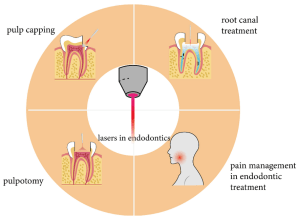Lasers In Endodontic
Endodontics is the branch of dentistry that deals with the diagnosis, treatment, and prevention of dental pulp diseases. Laser technology has become increasingly popular in the field of endodontics, as it offers several advantages over traditional treatment methods.
Lasers are devices that emit light of a specific wavelength, which can be used to target specific tissues. In endodontics, lasers can be used for a variety of purposes, including disinfection of root canals, removal of bacteria and debris, and shaping of the canal walls.
FEATURES
In endodontic treatment, there are two main types of lasers used:
Hard tissue lasers and Soft tissue lasers.
Hard tissue lasers are used to cut through hard tissues such as enamel, dentin, and bone. Hard tissue lasers commonly used in endodontic treatment include the Erbium, Chromium: Yttrium-Scandium-Gallium-Garnet (Er,Cr:YSGG) laser and the Carbon Dioxide (CO2) laser.
Soft tissue lasers, on the other hand, are used to cut or ablate soft tissues, such as gum tissue, oral mucosa, and other soft tissues. They are often used for procedures such as gingivectomy, gingivoplasty, and to remove granulation tissue from the periapical region of the tooth.
Soft tissue lasers commonly used in endodontic treatment include the Diode laser and the Neodymium-doped Yttrium Aluminium Garnet (Nd:YAG) laser.
HARD TISSUE LASERS
Hard tissue lasers can be used in endodontic treatment or surgery for a variety of purposes, including: Accessing the root canal, removing caries, Reshaping the tooth, Sterilizing the root canal, Apicoectomy.
There are several types of hard tissue lasers used in endodontics. The most commonly used types:
- Erbium, Chromium: Yttrium-Scandium-Gallium-Garnet (Er,Cr:YSGG) laser: This laser is commonly used in endodontics because it can be absorbed by water and hydroxyapatite, making it effective for cutting through hard tissues such as enamel, dentin, and bone. It is particularly useful for accessing the root canal and removing caries.
- Carbon Dioxide (CO2) laser: This laser can be used to remove caries and shape the tooth, but it is less commonly used in endodontics because it can also damage healthy tissues if not used properly.
- Erbium: Yttrium-Aluminum-Garnet (Er:YAG) laser: This laser is also effective for cutting through hard tissues, but it is less commonly used in endodontics than the Er,Cr:YSGG laser.
- Neodymium-doped Yttrium Aluminium Garnet (Nd:YAG) laser: This laser is primarily used for soft tissue procedures, but it can also be used for hard tissue procedures in endodontics.
SOFT TISSUE LASER
They can be used to remove diseased tissue more precisely, without damaging surrounding healthy tissue. They can also help to reduce bleeding and post-operative pain, as they can seal blood vessels and nerve endings as they cut. Additionally, soft tissue lasers can help to sterilize the surgical site, reducing the risk of infection.
There are two main types of soft tissue lasers used in endodontic surgery:
- Diode laser: This laser emits a concentrated beam of light in the infrared wavelength range, which is absorbed by pigmented tissues such as gums and oral mucosa. Diode lasers are commonly used in endodontics for procedures such as gingivectomy, gingivoplasty, and to remove granulation tissue from the periapical region of the tooth.
- Neodymium-doped Yttrium Aluminium Garnet (Nd:YAG) laser: This laser emits a beam of light in the near-infrared range and is effective for cutting through soft tissues. Nd:YAG lasers are also commonly used in endodontics for procedures such as gingivectomy and periapical surgery.
ADVANTAGES
- Greater Precision: Lasers can target specific tissues and areas with high precision, allowing for more accurate and conservative treatment.
- Cavity detection: Lasers can detect tooth decay before it is visible on an X-ray, allowing for earlier intervention and treatment.
- Teeth whitening: Lasers can be used to activate whitening agents and speed up the teeth whitening process.
- Disinfection: Lasers can effectively kill bacteria and viruses in the root canal system, reducing the risk of reinfection.
- Minimal discomfort: Laser treatment is generally less invasive and less painful than traditional treatment methods.
- Preservation of healthy tissue: Lasers can selectively remove diseased or damaged tissue while preserving healthy tissue, reducing the need for more extensive treatment.
- Improved and Faster healing: Lasers can stimulate cell growth and promote faster healing, reducing recovery time for the patient.
- Reduced bleeding: Lasers can cauterize blood vessels during treatment, reducing bleeding and improving visibility.
- Reduced risk of complications: Lasers are less likely to cause damage to surrounding tissues or to perforate the root canal wall, reducing the risk of complications.
DISADVANTAGES
While the use of lasers in endodontics has several benefits, it also has some limitations.
- Cost: Laser equipment is expensive, and the cost of acquiring and maintaining it can be a barrier for some dental practices.
- Learning curve: Learning how to use lasers in endodontic treatment requires specialized training and experience.
- Safety concerns: The use of lasers in endodontic treatment can pose some safety concerns, such as eye damage to the patient and dental staff if proper eye protection is not used.
Globally , the best brand for Dental Lasers is Biolase’s Dental Lasers. For soft tissues, their product is Epic X and or hard tissue lasers they have Waterlase iPlus and MDX.

CONCLUSION
With the use of LASERS in endodontic procedures or surgeries, Dentist can accelerate the growth in their practice and improve their patient outcomes also.
Though the cost is a bit high for lasers, but it will definitely prove to be a better investment for a successful and ever-growing dental practice. Staying up-to-date and making patients comfort and value for time, a priority is never going to harm anyone. It will rather make you exceptional than the others.
Increased productivity, efficient and effective treatment plans and their outcomes , minimally invasive painless and quick procedures with faster healing , are all what a dentist and the patient desires of.
In conclusion, lasers have become an increasingly popular tool in dentistry due to their effects like precision, reduced pain and discomfort, reduced bleeding and swelling, increased efficiency, and improved outcomes in certain procedures. While there are some disadvantages associated with their use, such as cost, a learning curve, limited indications, safety concerns, and a lack of long-term studies, the benefits of lasers in dentistry make them a valuable addition to the dental toolbox. With proper training and equipment, dentists can use lasers to improve the patient experience and achieve better outcomes in a variety of dental procedures.






Leave a comment